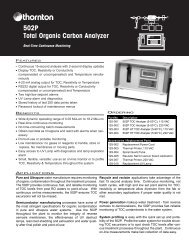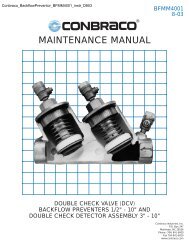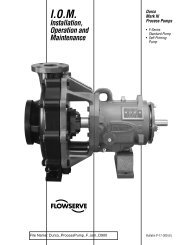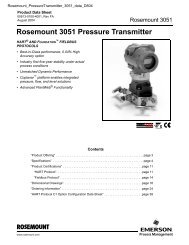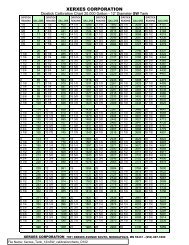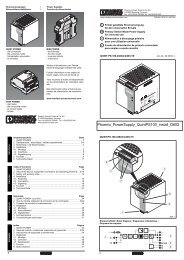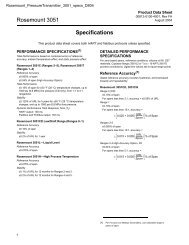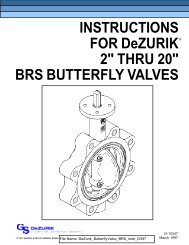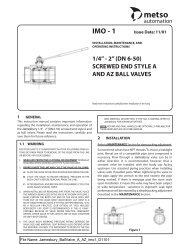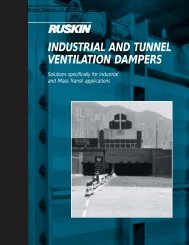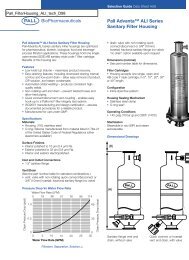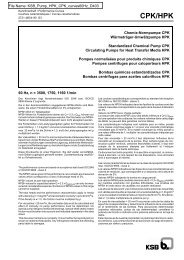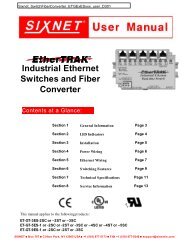Connections
Connections
Connections
You also want an ePaper? Increase the reach of your titles
YUMPU automatically turns print PDFs into web optimized ePapers that Google loves.
EXPRESS EXPRESS EXPRESS SETUP<br />
SETUP<br />
SETUP<br />
PanelMate 1700 Series<br />
PanelMate Power Series<br />
Cutler-Hammer
Installation<br />
Unpacking<br />
Carefully remove all equipment from the packing<br />
cartons and inspect all parts for damage in<br />
shipment. Check packing cartons for all items<br />
shown on the packing list. Keep the cartons and<br />
packing materials for future shipment.<br />
Report any damage to the carrier who delivered the<br />
equipment, then contact your Cutler-Hammer<br />
distributor. If you purchased the equipment from<br />
Cutler-Hammer, call the Order Processing<br />
Department at (614) 882-3282. Note: The Interstate<br />
Commerce Commission has a time limit on<br />
reporting concealed damage.<br />
Parts Checklist<br />
Your packing carton contains one parts kit<br />
containing:<br />
1 Packet of mounting nuts and washers<br />
2 Two-terminal connectors (audio output &<br />
security keyswitch)<br />
1 Three-terminal connector (24VDC power)<br />
1 Four-terminal connector (fault relay)<br />
Mounting<br />
Your PanelMate Power Series unit is designed for<br />
NEMA 4, 4X, and 12 installations when properly<br />
mounted in a correspondingly-rated enclosure.<br />
Proper installation and enclosure sizing is essential<br />
to ensure long life and trouble-free operation. Your<br />
PanelMate unit should always be mounted in a<br />
vertical position. Flat or angled mounting positions<br />
will shorten the unit's life.<br />
Refer to Cutler-Hammer's PanelMate Power Series<br />
Installation Guide for installation recommendations.<br />
The Guide is available on the Cutler-Hammer web<br />
site:<br />
www.cutlerhammer.eaton.com/automation<br />
Panel cutout dimensions and stud torque limits are<br />
shown on the reverse side of this Express Setup<br />
sheet.<br />
Note: Stud nuts must be tightened enough to<br />
obtain a proper seal, but not over-tightened<br />
to the point where the threads are stripped<br />
or the gasket is rendered useless. Always<br />
use a torque wrench when installing your<br />
PanelMate Power Series unit.<br />
Safety Considerations<br />
This equipment is suitable for Class I, Division 2,<br />
Groups (A,B,C,D) or non-hazardous locations only.<br />
EXPLOSION HAZARD. SUBSTITUTION OF<br />
COMPONENTS MAY IMPAIR SUITABILITY FOR<br />
CLASS 1, DIVISION 2.<br />
RISQUE D'EXPLOSION. LA SUBSTITUTION DE<br />
COMPOSANTS PUET RENDRE CE MATERIAL<br />
INACCEPTABLE POUR LES EMPLACEMENTS<br />
DE CLASSE 1, DIVISION 2.<br />
EXPLOSION HAZARD. DO NOT REPLACE<br />
COMPONENTS UNLESS POWER HAS BEEN<br />
SWITCHED OFF OR AREA IS KNOWN TO BE<br />
NON-HAZARDOUS.<br />
RESQUE D'EXPLOSION. COUPER LE COURANT<br />
OU S'ASSURER QUE L'EMPLACEMENT ES<br />
DESIGNE NON DANGEREUX AVANT DE<br />
REPLACER LE COMPOSANTS.
<strong>Connections</strong><br />
Connect DC Power<br />
Your PanelMate unit operates at 24VDC -<br />
15%/+20%. A removable three-position DC power<br />
connector attaches to the unit's connector<br />
receptacle as shown in the diagram below. The DC<br />
input common (-terminal) and the chassis GND<br />
terminal are both internally connected to the<br />
PanelMate chassis.<br />
Note: Use #18 AWG (0.82mm2) copper wire for<br />
power and ground lead connections.<br />
Note: Power conditioning may be required when<br />
the PanelMate unit is installed in areas of<br />
poor power quality.<br />
_GND<br />
+<br />
Your PanelMate unit could be damaged if it is<br />
connected to voltages outside the range of 18 to<br />
30VDC. Your PanelMate unit is fully protected<br />
against polarity reversal and will not operate if<br />
input polarity is reversed.<br />
If you are replacing a PanelMate Power Series<br />
1500 unit, check the rating of your existing<br />
24VDC power supply. The PanelMate 1700 unit<br />
requires a power supply rated for 1.5A<br />
operation.<br />
Connection to a Personal Computer<br />
Executive firmware and PanelMate configurations<br />
are uploaded/downloaded to a PC using the<br />
PanelMate unit's serial port. A download serial<br />
cable is provided with your PanelMate<br />
Configuration software. Refer to your PanelMate<br />
Power Series Getting Started Manual for more<br />
information.<br />
Connection to the Fault Relay<br />
The fault relay may be wired in normally open or<br />
normally closed configuration. It is a Form C<br />
contact, rated for 2 amps at 120VAC, 2 amps at<br />
230VAC, and 2 amps at 28VDC resistive load.<br />
During normal operation, the fault relay will<br />
energize after entering Run Mode. Whenever the<br />
PanelMate unit detects a communication error or<br />
system failure, the fault relay will be de-energized. It<br />
is also possible to de-energize the fault relay<br />
whenever an alarm condition occurs. You can set<br />
the fault relay to de-energize on alarms by using the<br />
System Parameters Table. Refer to the System<br />
Parameters topic in the Configuration Software<br />
Online Help and in the Configuration Editor User's<br />
Guide for more information.<br />
Connection to the Audio Output<br />
The Audio Feedback Kit is an optional accessory to<br />
your PanelMate unit. To connect the external 8Ohm<br />
speaker to your PanelMate unit, connect the<br />
speaker to the Audio connector.<br />
Connection to the Security Keyswitch<br />
The Security Keyswitch connection is provided for<br />
external security/password applications.
Connection to Serial Ports<br />
Serial Port 1 may be used for a printer, for PLC (or<br />
Host) communications, or for connection to a<br />
personal computer for upload or download. Serial<br />
Port 2 may be used for a printer or, for PLC (or Host)<br />
communications.<br />
Selection of Port 1 for a Serial Printer must be done<br />
with the Configuration Software. Refer to the PLC<br />
Name and Port Table topic in the Configuration<br />
Software Online Help and in the PanelMate Power<br />
Series Configuration Editor User's Guide.<br />
Serial Port Termination<br />
Your PanelMate unit is sent without termination. For<br />
serial port termination switch locations, refer to<br />
Figure A. Recommended termination for RS232,<br />
DH485 and RS422 communication is shown in the<br />
table. For setting the termination on Serial Port 1,<br />
use the termination switch on the left of Serial Port 1.<br />
For setting the termination on Serial Port 2, use the<br />
termination switch to the right of Serial Port 2.<br />
24V<br />
+ -<br />
KYSW<br />
120WAC 120W<br />
220W<br />
NONE<br />
/RS232<br />
Your PanelMate unit is equipped with isolated<br />
serial ports for improved communications<br />
reliability. If you are replacing a 120VAC Power<br />
Series unit or a Power Series 1500 unit, and are<br />
using an RS422 or RS485 cable for PLC<br />
communications, you will need to install a new<br />
cable equipped with a ground wire. Consult<br />
your PLC Communications driver manual or<br />
contact Cutler-Hammer Support Services for<br />
more information.<br />
1 2 3 4<br />
SERIAL PORT 1 SERIAL PORT 2<br />
Figure A<br />
1<br />
2<br />
3<br />
4<br />
5<br />
6<br />
7<br />
8<br />
9<br />
Pin Description<br />
1 RS422 Transmit Data (+) (Output)<br />
2 RS232 Receive Data (Input)<br />
3 RS232 Transmit Data (Output)<br />
4 RS422 Receive Data (+) (Input)<br />
5 Signal Ground<br />
6 RS422 Transmit Data (-) (Output)<br />
7 RS232 Request to Send (Output)<br />
8 RS232 Clear to Send (Input)<br />
9 RS422 Receive Data (-)<br />
Communication Position Termination<br />
RS 232 1 None (factory Setting)<br />
DH 485 4 120 Ohm AC coupled<br />
RS422/RS485 2 & 3 Refer to your PLC<br />
Communications Driver<br />
Manual for termination<br />
information<br />
120WAC 120W<br />
220W<br />
NONE<br />
/RS232<br />
1 2 3 4<br />
N/C<br />
FAULT RELAY<br />
AUDIO
Tests & Adjustments<br />
PanelMate Diagnostic Tests<br />
When power is applied to you PanelMate unit, the<br />
unit will display a listing of internal diagnostic<br />
checks as they are executed. After completing its<br />
internal diagnostic checks, the unit will display the<br />
Offline Mode Menu. This menu displays six<br />
selections described below:<br />
Execute<br />
Diagnostics<br />
Calibrate<br />
Touchscreen<br />
Enter<br />
Serial<br />
Transfer<br />
Mode<br />
Execute Diagnostics<br />
Enter<br />
Network<br />
Transfer<br />
Mode<br />
This template allows you to perform a series of<br />
tests:<br />
Set Date and Time<br />
Display test<br />
Touchscreen test<br />
Tone, relay and battery test<br />
Serial port test<br />
For information on performing these tests, refer to<br />
your PanelMate Power Series Getting Started<br />
Manual.<br />
Enter Serial Transfer Mode<br />
To download, upload or read system information<br />
over a serial port, your PanelMate unit must be in<br />
Serial Transfer Mode. For more information on<br />
downloading and uploading PanelMate Power<br />
Series configurations, refer to your PanelMate<br />
Power Series Getting Started Manual.<br />
Enter Network Transfer Mode<br />
Display<br />
System/<br />
Config.<br />
Information<br />
Enter<br />
Run<br />
Mode<br />
Network transfer mode is used to read system<br />
information over a remote network or remotely place<br />
your PanelMate unit into Run Mode. For more<br />
information, refer to your PanelMate Transfer Utility<br />
User's Manual.<br />
Display System Configuration Information<br />
This selection displays your PanelMate unit's<br />
current configuration. Your PanelMate unit is<br />
shipped with a demonstration PanelMate Power<br />
Series configuration. Once you have downloaded a<br />
new configuration, this information will be updated<br />
to reflect the new configuration information.<br />
Enter Run Mode<br />
Run Mode allows you to display the configuration<br />
downloaded to the PanelMate unit and<br />
communicate to the PLC of your choice. If a new<br />
configuration has not been downloaded, the unit will<br />
display the demonstration configuration. For more<br />
information on Run Mode, refer to your PanelMate<br />
Power Series Getting Started Manual.<br />
Calibrate Touchscreen<br />
Touchscreen units have a calibration routine that<br />
must be performed to determine the boundaries of<br />
the video on your touchscreen. Refer to<br />
Touchscreen Information for instructions on<br />
calibrating the touchscreen.<br />
Display Contrast Adjustment<br />
Units equipped with grayscale or dual-scan color<br />
displays feature software-controlled contrast<br />
adjustment. To adjust the contrast, follow these<br />
steps:<br />
1) Place the unit in Run Mode<br />
2) Select the Get Page control button from the<br />
default control buttons<br />
3) Select the More control button<br />
4) Select the Setup Page control button<br />
5) Select the Adjust Contrast control button and use<br />
the Lighter and Darker control buttons to adjust<br />
the display's contrast.<br />
To save the new setting, press the Save Setting<br />
control button. To revert to the previous contrast<br />
setting, press the Cancel key. The unit will return to<br />
the last saved contrast level after power is cycled to<br />
the unit.
TouchPanel Information<br />
PanelMate Operation<br />
The most basic job of a PanelMate unit is to replace<br />
the functions of hard-wired operator station devices<br />
such as pushbuttons, lamps and message displays.<br />
To replace these devices, the PanelMate unit<br />
supplies a "template".<br />
During operation, you can select a template to<br />
"arm" control buttons or numeric entry. Once a<br />
template has been selected or "armed", you can<br />
press any desired control button to take action.<br />
The touchscreen is designed for finger or gloved<br />
operation only, and does not require the same<br />
actuation force as a mechanical switch. A light<br />
touch will produce the same result as a heavy one.<br />
For more information refer to your PanelMate<br />
Power Series Online Operation User's Guide.<br />
Touchscreen Cleaning<br />
Pressing directly on the<br />
display will activate a template.<br />
A Cleaning Mode utility is provided to make<br />
touchscreen cleaning safe and easy. To access it:<br />
1) Place the PanelMate unit is Run Mode.<br />
2) Select the Get Page control button f<br />
3) Select the More control button.<br />
4) Select the Setup Page control button<br />
5) Select the Cleaning Mode template.<br />
6) Press the Execute control button<br />
After pressing the Execute button, the Cleaning<br />
Mode screen will appear. While this screen is<br />
displayed, the touchscreen will not respond to your<br />
tough. After you have finished cleaning the<br />
touchscreen, you must return to normal operation<br />
by pressing the screen's numbered corners in<br />
sequential order: 1,2,3,4.<br />
1<br />
3<br />
TOUCH KEYS 1-2-3-4 IN<br />
SEQUENCE TO UNLOCK<br />
10:27:53<br />
2<br />
4<br />
Touchscreen Calibration<br />
You can calibrate your unit's touchscreen in both<br />
Offline and Run modes. To access the calibration<br />
screen when in Offline mode, select the Calibrate<br />
Touchscreen template on the Offline Mode Menu. To<br />
access the calibration in Run mode:<br />
1) Select the Get Page control button from the<br />
default control buttons<br />
2) Select the More control button<br />
3) Select the Setup Page control button<br />
4) Select the Calibrate Touchscreen control button<br />
5) Press the Execute control button<br />
Although the Offline and Run mode calibration<br />
screens are slightly different in appearance, they<br />
both use the same calibration process. To calibrate,<br />
press the eight boxes/crosshairs located around the<br />
screen edges. You may press them in any order, but<br />
all must be pressed to calibrate.<br />
Each box/crosshair will turn green (different shade<br />
of gray on grayscale units) when pressed. After the<br />
first pass, the boxes/crossharis will change color to<br />
indicate the screen is ready for the second pass.<br />
Again, press all eight boxes/crosshairs around the<br />
screen edge. When you have pressed the last, the<br />
unit will return to normal operation.<br />
Press these<br />
boxes/crosshairs<br />
twice, in order<br />
(1,2,3,4,1,2,3,4)<br />
Touchscreen Calibration Program<br />
Copyright (c) Cutler-Hammer 1996. All rights reserved.<br />
CANCEL<br />
10:27:53<br />
PRESS AND HOLD EACH BOX ALONG EDGES FOR 1 SEC.<br />
Pass1of2<br />
Never use foreign objects (pens, screwdrivers<br />
or similar) to activate the touchscreen. Foreign<br />
objects may damage the touchscreen, causing<br />
unreliable operation or failure.<br />
Do not use solvents or other harsh cleaning<br />
compounds on the touchscreen. Solvents and<br />
abrasive cleaning compounds will cause<br />
permanent damage to the touchscreen.
Cutout Template<br />
Care should be taken when tightening the<br />
nuts. The fasteners must be tightened<br />
enough to obtain a proper seal, but not over<br />
tightened to the point where the threads are<br />
stripped or the gasket is rendered useless.<br />
Always use a torque wrench when installing<br />
your PanelMate Power Series unit.<br />
3.47<br />
(88.1)<br />
3.47<br />
(88.1)<br />
1.65<br />
(41.9)<br />
1.50<br />
(38.1)<br />
4.91<br />
(124.7)<br />
3.26<br />
(82.8)<br />
9.38<br />
(238.2)<br />
Cutout<br />
Torque Limits for Studs<br />
5 inch-pounds for #6-32 nuts<br />
This cutout drawing is not 1:1 scale. Refer to<br />
the Express Setup sheet included with your<br />
PanelMate Power Series unit for a 1:1 template.<br />
3.26<br />
(82.8)<br />
Notes:<br />
Dimensions are in inches.<br />
Millimeter dimensions are in parentheses.<br />
4.91<br />
(124.7)<br />
4.69<br />
(119.1)<br />
.187 Diameter Hole<br />
(4.75)<br />
3.25<br />
(82.6)<br />
6.50<br />
(165.1)<br />
9.38<br />
(238.2)
Specifications<br />
Temperature<br />
Operating: 0 to 50 degree C (grayscale & TFT color)<br />
0 to 40 degree C (dual-scan color)<br />
Non-Operating: -20 to 60 degree C<br />
Humidity (non-condensing)<br />
Operating: 20% - 80% (grayscale)<br />
20% - 90% (color)<br />
Non-Operating: 20% - 90% (grayscale)<br />
20% - 95% (color)<br />
NEMA Class: NEMA 4, NEMA 4X, or NEMA 12<br />
Vibration<br />
Operating: 1g at 10-500Hz<br />
Non-Operating 1g at 10-500Hz<br />
Shock<br />
Operating: 30g<br />
Non-Operating: 30g<br />
Pollution: Pollution Degree 1 - Rated for exposure to<br />
dry or non-conductive pollutants only<br />
Altitude<br />
Operating: 10,000 feet above sea level<br />
Non-Operating: 40,000 feet above sea level<br />
ESD Immunity<br />
Air: IEC 1000-4-2, Level 4 (+/- 15kV)<br />
Contact: IEC 1000-4-2, Level 4 (+/- 8kV)<br />
Radiated Immunity: IEC 1000-4-3 (10V/m) 27mHz to<br />
1GHz 80% AM modulation<br />
Conducted Immunity: IEC 1000-4-6 10V from 150kHz to 80mHZ,<br />
80% AM modulation with 1kHz sine wave<br />
Surge Immunity: IEC 1000 - 4-5 2kV<br />
Radiated/Conductive CISPR 22, Class A Emission<br />
Electrical Fast Transient:IEC 1000-4-4, Level 3 (2kV) on power<br />
lines (1kV) on I/O lines<br />
Line Frequency Magnetic IEC 1000-4-8 Level 3, 30A/m at 50Hz<br />
Field Immunity: and 60Hz
Voltage: 24VDC -15%/+20% @28W<br />
(with Fieldbus Interface installed)<br />
24VDC -15%/+20% @23W<br />
(without Fieldbus Interface installed)<br />
Current: 1.3A (with Fieldbus Interface installed)<br />
1.1A (without Fieldbus Interface installed)<br />
Peak Inrush Current: 5A<br />
Serial Port Rate: Selectable; 110 to 38,400 baud<br />
Serial Port 1 Configuration: DB9S connection selectable for<br />
RS232, RS422, or RS485-2<br />
signal levels<br />
Serial Port 2 Configuration: DB9S connection selectable for<br />
RS232, RS422, or RS485-2<br />
signal levels<br />
Weight: 4 Lbs<br />
5 Lbs with Fieldbus interface attached<br />
Support Services<br />
Technical Support<br />
1-800-809-2772 Voice<br />
1-614-882-0417 Fax<br />
Information Fax-Back<br />
614-899-5323<br />
Website<br />
http://www.cutlerhammer.eaton.com/automation<br />
Technical Support E-mail<br />
chatechsupport@ch.etn.com<br />
Cutler-Hammer<br />
173 Heatherdown Drive<br />
Westerville, OH 43081<br />
614-882-3282<br />
P/N 01-00401-03



